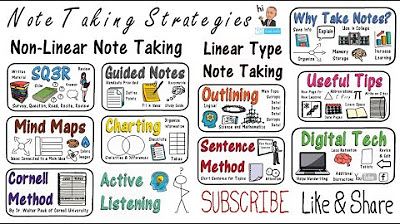Note Taking
Summary
TLDRThis video explains five effective note-taking methods: the Cornell method, mapping method, outlining method, charting method, and sentence method. The Cornell method divides the page into three sections for main notes, review, and conclusions. The mapping method creates visual layouts with subtopics branching from the main topic. The outlining method organizes notes hierarchically. The charting method uses columns to categorize information. The sentence method lists individual topics on each line. These methods help students organize and review their notes effectively for better learning.
Takeaways
- 😀 There are five methods for taking notes.
- 😀 The Cornell method divides the paper into three parts: a section on the left for cues, a bottom section for conclusions, and a larger section for the main notes.
- 😀 In the Cornell method, notes are taken during class in the main section, reviewed in the cues section, and conclusions are written at the bottom.
- 😀 The Mapping method involves creating a visual map starting with the main topic, branching out to subtopics, and adding details beneath each subtopic.
- 😀 In the Mapping method, the pattern of subtopics and details continues outward from the main topic.
- 😀 The Outlining method starts with the main topic, followed by subtopics and supporting facts underneath.
- 😀 The Charting method organizes notes into columns labeled with categories, with details written under the appropriate category.
- 😀 The Sentence method involves writing each line as a separate topic, often using headings to organize the notes.
- 😀 The various note-taking methods can be used to improve understanding and retention of material.
- 😀 Note-taking is an effective tool for studying, helping students reinforce and comprehend material during class and independent learning.
- 😀 To be successful in note-taking, students should be proactive in using different methods to organize their notes and understand key concepts.
Q & A
What is the Cornell method of note-taking?
-The Cornell method divides the paper into three sections: a 2/5 inch section on the left for cues, a 2-inch section at the bottom for a summary, and a 6-inch section on the right for the main notes. The main body is used for taking notes during class, while the left section is for review and questions, and the bottom section is for summarizing key points.
How does the mapping method work in note-taking?
-In the mapping method, you start by writing the main topic at the center of the page, then branch out with subtopics. Each subtopic is accompanied by key details or important points, creating a visual representation of the topic’s structure and relationships.
What is the purpose of the conclusion section in the Cornell method?
-The conclusion section in the Cornell method is used to summarize the main points of the notes. It allows the student to reflect on what they have learned and highlight the most important aspects of the material.
What is the main difference between the mapping and outlining methods?
-The mapping method focuses on visual representation with topics branching out from the center, while the outlining method organizes notes in a hierarchical structure, with main topics followed by subtopics and supporting facts beneath them.
How does the charting method help in organizing notes?
-The charting method involves dividing the page into columns labeled with different categories. Key details related to each category are written under the appropriate column, making it easier to compare and contrast information.
What is the main characteristic of the sentence method?
-In the sentence method, each line of the notes is treated as a new and separate topic. This allows the student to capture detailed information but requires careful organization, often with headings to distinguish main topics.
Why is note-taking considered an effective study method?
-Note-taking helps students organize information, review and reinforce learning, and improve retention. It also provides a structured medium to understand and reflect on material, making it easier to review later.
What is the role of the cue section in the Cornell method?
-The cue section in the Cornell method is used for writing questions, keywords, or prompts that can later help with reviewing and recalling the material during study sessions.
How should students use the mapping method effectively during class?
-During class, students should begin by noting the main topic in the center and then add subtopics as they emerge. They should focus on capturing key points under each subtopic to create a visual structure of the material.
How does the sentence method differ from other methods in terms of organization?
-The sentence method is less structured compared to other methods, as each line represents a new topic. Unlike methods like outlining, which use hierarchies, the sentence method focuses on capturing each point individually without clear categorization.
Outlines

This section is available to paid users only. Please upgrade to access this part.
Upgrade NowMindmap

This section is available to paid users only. Please upgrade to access this part.
Upgrade NowKeywords

This section is available to paid users only. Please upgrade to access this part.
Upgrade NowHighlights

This section is available to paid users only. Please upgrade to access this part.
Upgrade NowTranscripts

This section is available to paid users only. Please upgrade to access this part.
Upgrade Now5.0 / 5 (0 votes)





